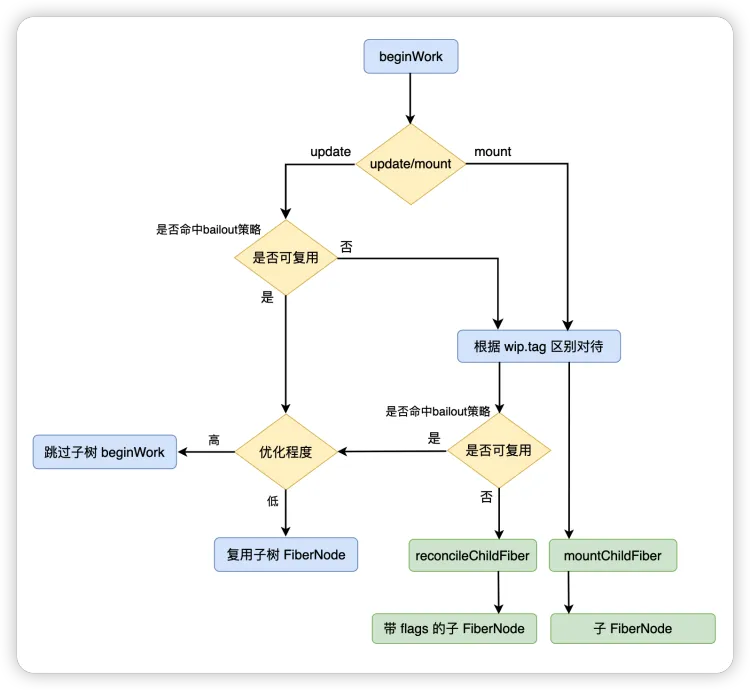面试题:谈一谈 React 中的 bailout 策略
前面我们学习 beginWork 的时候,我们知道 beginWork 的作用主要是生成 wipFiberNode 的子 FiberNode,要达到这个目录存在两种方式:
- 通过 reconcile 流程生成子 FiberNode
- 通过命中 bailout 策略来复用子 FiberNode
在前面我们讲过,所有的变化都是由“自变量”的改变造成的,在 React 中自变量:
- state
- props
- context
因此是否命中 bailout 主要也是围绕这三个变量展开的,整体的工作流程如下:

从上图可以看出,bailout 是否命中发生在 update 阶段,在进入 beginWork 后,会有两次是否命中 bailout 策略的相关判断
第一次判断
第一次判断发生在确定了是 update 后,立马就会进行是否能够复用的判断:
- oldProps 全等于 newProps
- Legacy Context 没有变化
- FiberNode.type 没有变化
- 当前 FiberNode 没有更新发生
oldProps 全等于 newProps
注意这里是做的一个全等比较。组件在 render 之后,拿到的是一个 React 元素,会针对 React 元素的 props 进行一个全等比较。但是由于每一次组件 render 的时候,会生成一个全新的对象引用,因此 oldProps 和 newProps 并不会全等,此时是没有办法命中 bailout。
只有当父 FiberNode 命中 bailout 策略时,复用子 FiberNode,在子 FiberNode 的 beginWork 中,oldProps 才有可能和 newProps 全等。
备注:视频中这里讲解有误,不是针对 props 属性每一项进行比较,而是针对 props 对象进行全等比较。上面的笔记内容已修改。
Legacy Context 没有变化
Legacy Context指的是旧的 ContextAPI,ContextAPI重构过一次,之所以重构,就是和 bailout策略相关。
FiberNode.type 没有变化
这里所指的 FiberNode.type 没有变化,指的是不能有例如从 div 变为 p 这种变化。
function App(){
const Child = () => <div>child</div>
return <Child/>
}在上面的代码中,我们在 App 组件中定义了 Child 组件,那么 App 每次 render 之后都会创建新的 Child 的引用,因此对于 Child 来讲,FiberNode.type 始终是变化的,无法命中 bailout 策略。
因此不要在组件内部再定义组件,以免无法命中优化策略。
当前 FiberNode 没有更新发生
当前 FiberNode 没有发生更新,则意味着 state 没有发生变化。
例如在源码中经常会存在是否有更新的检查:
function checkScheduledUpdateOrContext(current, renderLanes) {
// 在执行 bailout 之前,我们必须检查是否有待处理的更新或 context。
const updateLanes = current.lanes;
if (includesSomeLane(updateLanes, renderLanes)) {
// 存在更新
return true;
}
//...
// 不存在更新
return false;
}当以上条件都满足的时候,会命中 bailout 策略,命中该策略后,会执行 bailoutOnAlreadyFinishedWork 方法,在该方法中,会进一步的判断优化程序,根据优化程度来决定是整颗子树都命中 bailout 还是复用子树的 FiberNode
function bailoutOnAlreadyFinishedWork(current, workInProgress, renderLanes) {
// ...
if (!includesSomeLane(renderLanes, workInProgress.childLanes)) {
// ...
// 整颗子树都命中 bailout 策略
return null;
}
// 该 FiberNode 没有命中 bailout,但它的子树命中了。克隆子 FiberNode 并继续
cloneChildFibers(current, workInProgress);
return workInProgress.child;
}通过 wipFiberNode.childLanes 就可以快速的排查当前的 FiberNode 的整颗子树是否存在更新,如果不存在,直接跳过整颗子树的 beginWork。
这其实也解释了为什么每次 React 更新都会生成一颗完整的 FiberTree 但是性能上并不差的原因。
第二次判断
如果第一次没有命中 bailout 策略,则会根据 tag 的不同进入不同的处理逻辑,之后还会再进行第二次的判断。
第二次判断的时候会有两种命中的可能:
- 开发者使用了性能优化 API
- 虽然有更新,但是 state 没有变化
开发者使用了性能优化 API
在第一次判断的时候,默认是对 props 进行全等比较,要满足这个条件实际上是比较困难的,性能优化 API 的工作原理主要就是改写这个判断条件。
比如 React.memo,通过该 API 创建的 FC 对应的 FiberNode.tag 为 MemoComponent,在 beginWork 中对应的处理逻辑如下:
const hasScheduledUpdateOrContext = checkScheduledUpdateOrContext(
current,
renderLanes,
);
if (!hasScheduledUpdateOrContext) {
const prevProps = currentChild.memoizedProps;
// 比较函数,默认进行浅比较
let compare = Component.compare;
compare = compare !== null ? compare : shallowEqual;
if (compare(prevProps, nextProps) && current.ref === workInProgress.ref) {
// 如果 props 经比较未变化,且 ref 不变,则命中 bailout 策略
return bailoutOnAlreadyFinishedWork(current, workInProgress, renderLanes);
}
}因此是否命中 bailout 策略的条件就变成了如下三个:
- 不存在更新
- 经过比较(浅比较)后 props 没有变化
- ref 没有发生改变
如果同时满足上面这三个条件,就会命中 bailout 策略,执行 bailoutOnAlreadyFinishedWork 方法。相较于第一次判断,第二次判断 props 采用的是浅比较进行判断,因此能够更加容易命中 bailout
例如再来看一个例子,比如 ClassComponent 的优化手段经常会涉及到 PureComponent 或者 shouldComponentUpdate,这两个 API 实际上背后也是在优化命中bailout 策略的方式
在 ClassComponnet 的 beginWork 方法中,有如下的代码:
if(!shouldUpdate && !didCaptureError){
// 省略代码
return bailoutOnAlreadyFinishedWork(current, workInProgress, renderLanes);
}shouldUpdate 变量受 checkShouldComponentUpdate 方法的影响:
function checkShouldComponentUpdate(
workInProgress,
ctor,
oldProps,
newProps,
oldState,
newState,
nextContext,
) {
// ClassComponent 实例
const instance = workInProgress.stateNode;
if (typeof instance.shouldComponentUpdate === 'function') {
let shouldUpdate = instance.shouldComponentUpdate(
newProps,
newState,
nextContext,
);
// shouldComponentUpdate 执行后的返回值作为 shouldUpdate
return shouldUpdate;
}
// 如果是 PureComponent
if (ctor.prototype && ctor.prototype.isPureReactComponent) {
// 进行浅比较
return (
!shallowEqual(oldProps, newProps) || !shallowEqual(oldState, newState)
);
}
return true;
}通过上面的代码中我们可以看出,PureComponent 通过浅比较来决定shouldUpdate的值,而shouldUpdate的值又决定了是否能够命中 bailout 策略。
虽然有更新,但是 state 没有变化
在第一次进行判断的时候,其中有一个条件是当前的 FiberNode 没有更新发生,没有更新就意味着 state 没有改变。但是还有一种情况,那就是有更新,但是更新前后计算出来的 state 仍然没有变化,此时就也会命中 bailout 策略。
例如在 FC 的 beginWork 中,有如下一段逻辑:
function updateFunctionComponent(
current,
workInProgress,
Component,
nextProps: any,
renderLanes,
) {
//...
if (current !== null && !didReceiveUpdate) {
// 命中 bailout 策略
bailoutHooks(current, workInProgress, renderLanes);
return bailoutOnAlreadyFinishedWork(current, workInProgress, renderLanes);
}
// ...
// 进入 reconcile 流程
reconcileChildren(current, workInProgress, nextChildren, renderLanes);
return workInProgress.child;
}在上面的代码中,是否能够命中 bailout 策略取决于 didReceiveUpdate,接下来我们来看一下这个值是如何确定的:
// updateReducer 内部在计算新的状态时
if (!is(newState, hook.memoizedState)) {
markWorkInProgressReceivedUpdate();
}
function markWorkInProgressReceivedUpdate() {
didReceiveUpdate = true;
}真题解答
题目:谈一谈 React 中的 bailout 策略
参考答案:
在 beginWork 中,会根据 wip FiberNode 生成对应的子 FiberNode,此时会有两次“是否命中 bailout策略”的相关判断。
- 第一次判断
- oldProps 全等于 newProps
- Legacy Context 没有变化
- FiberNode.type 没有变化
- 当前 FiberNode 没有更新发生
当以上条件都满足时会命中 bailout 策略,之后会执行 bailoutOnAlreadyFinishedWork 方法,该方法会进一步判断能够优化到何种程度。
通过 wip.childLanes 可以快速排查“当前 FiberNode 的整颗子树中是否存在更新”,如果不存在,则可以跳过整个子树的 beginWork。这其实也是为什么 React 每次更新都要生成一棵完整的 Fiebr Tree 但是性能并不差的原因。
- 第二次判断
- 开发者使用了性能优化 API,此时要求当前的 FiberNode 要同时满足:
- 不存在更新
- 经过比较(默认浅比较)后 props 未变化
- ref 不变
- 虽然有更新,但是 state 没有变化
- 开发者使用了性能优化 API,此时要求当前的 FiberNode 要同时满足:



